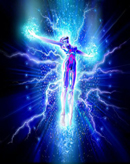|
The planetary alignments and their influence
The Planets are in Aspect when they are a certain distance from each other. In the simplest terms, the zodiac is a circle divided into twelve parts, each part containing 30 degrees of space and occupied by one of the twelve signs, through which each of the planets travel from west to east following their natural order from Aries to Pisces. The twelve signs measuring 30 degrees each constitute the 360 degrees of the Zodiac.
The aspects are the angles between two planets. The aspects or angles foretell the type of energy generated by the planets in the house which is being occupied. Remember, each house covers a different area of your life. You can read about those areas on the Houses page. 
Some aspects are harmonious, beneficial, positive and easy. These are considered to be Soft aspects.
Other Aspects are difficult, tense, bad or malefic. These are considered to be Hard aspects.
An easy aspect is one that requires little effort, whereas a hard aspect requires real work to overcome it. The strength of influence depends on the planets involved and how they relate to each other. The closer the aspect occurs within its orb (distance in degrees), the more important it becomes, whether it be a major or a minor one. Another way of understanding this would be if a planet touches another planet or comes very close in aspect it will have a definite influence in the area the planet occupies in your chart. If the planets are further away, you may not notice any influence or change at all.
The Conjunction 0 Degrees: Any two or more planets positioned in the chart within 6 degrees orb of one another are said to be conjunct. Its effects vary depending on the nature of the planets involved. The conjunction is the easiest aspect to note in a chart as the planets are unusually in the same sign, although planets can be conjunct if one planet is at the end of a sign (28 degrees) and the other at the beginning of the next sign (3 degrees).
The Semi-Sextile 30 degrees: Any two or more planets that form a 30 degree angle with each other are semi-sextile. This aspect allows a 2 degree orb or variance on either side of the 30 degree angle. The effects are usually favorable, but the planets involved should be considered.
The Sextile 60 degrees: Any two or more planets that form a 60 degree angle with each other with an allowable orb of 6 degrees are Sextile. This is one of the most beneficial aspects as planets are usually in elementally compatible signs to one another. This aspect usually represents opportunity and talents that are well utilized.
The Square 90 degrees: Any two or more planets that form a 90 degree angle with each other with an allowable orb of 6 degrees are Square. The Square is a major aspect and usually the most potent aspect after the conjunction. The square can be difficult; however, if overcome, the results can prove to be quite beneficial in time and with patience.
The Trine 120 degrees: Any two or more planets that form a 120 degree angle with each other with an allowable orb of 6 degrees are in Trine aspect. The trine usually occurs between signs of the same element (Water, Earth, Air and Fire) however, it is possible for a trine to be formed between incompatible signs. The trine is a harmonious aspect and can show great talent or opportunity when the person is motivated.
The Quincunx/Inconjunct 150 degrees: Having two names shows the complex nature of this aspect. Planets are Inconjunct when they are 150 degrees apart with an allowable orb of 3 degrees. The two signs involved are almost always of a different element. This is a minor aspect, but somewhat difficult in nature and is often related to ill health, stress and adjustments. As with the Square aspects, the Inconjunct can also prove beneficial when utilized positively and can provide diverse talents and creative potential.
 The Opposition 180 Degrees: The Opposition, as its name describes relates to two planets that are directly opposite one another with an allowable orb of 6 degrees. The opposition is the most powerful aspects after the conjunction and square. This aspect produces difficulties and creates tension that must be reconciled, thereby increasing the range of possibilities. With the exception of the Inconjunct, when the Sun, Moon or Ascendant is in aspect, an 8 degree orb (distance) is allowed. Astrologers often differ in their usage of allowable orbs, although usually not by more than 2 degrees. The Opposition 180 Degrees: The Opposition, as its name describes relates to two planets that are directly opposite one another with an allowable orb of 6 degrees. The opposition is the most powerful aspects after the conjunction and square. This aspect produces difficulties and creates tension that must be reconciled, thereby increasing the range of possibilities. With the exception of the Inconjunct, when the Sun, Moon or Ascendant is in aspect, an 8 degree orb (distance) is allowed. Astrologers often differ in their usage of allowable orbs, although usually not by more than 2 degrees.
|